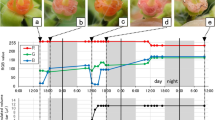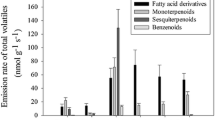Abstract.
Quantitative headspace analyses of rose flowers showed no significant differences in composition of emitted volatile compounds between flowers on the intact plant and cut flowers placed in vase water containing sucrose at 0, 15 or 30 g · l−1. Volatile components emitted were geraniol, nerol, citronellol, E-citral, Z-citral, methylgeranylate, trans-caryophyllene, β-cubebene, dihydro-β-ionone, 2-phenylethanol, 2-phenylethylacetate, 3,5-dimethoxytoluene and hexylacetate. When exposed to a 12-h photoperiod these components showed maximum emission during the light period and a rhythmicity which differed for the individual compounds. The circadian nature of the rhythmicity was confirmed by the continuation of rhythmicity during continued darkness or light, and was characterized by `transient' and `free running' periods of 27 and 24 h, respectively, and a phase shift of 12 h in rhythmicity when a 24-h period of continuous darkness was followed by re-exposure to a 12-h photoperiod. Rhythmicity in emission was not observed when flowers were kept in darkness before flower bud opening, but started immediately upon exposure to a 12-h photoperiod.
Similar content being viewed by others
Author information
Authors and Affiliations
Additional information
Received: 14 April 1998 / Accepted: 28 May 1998
Rights and permissions
About this article
Cite this article
Helsper, J., Davies, J., Bouwmeester, H. et al. Circadian rhythmicity in emission of volatile compounds by flowers of Rosa hybrida L. cv. Honesty. Planta 207, 88–95 (1998). https://doi.org/10.1007/s004250050459
Issue Date:
DOI: https://doi.org/10.1007/s004250050459




